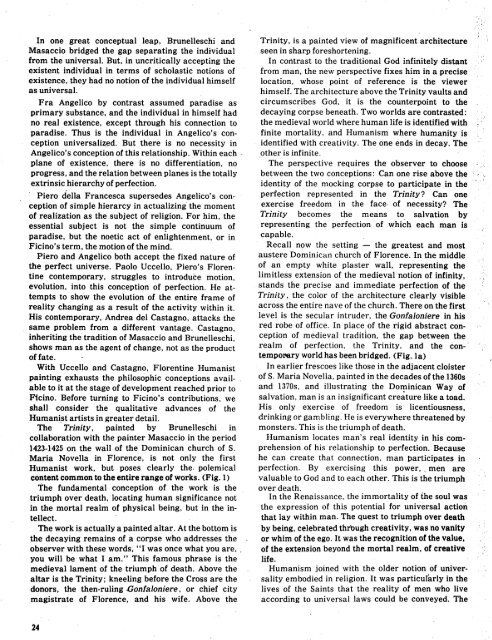Renaissance and
Renaissance and
Renaissance and
You also want an ePaper? Increase the reach of your titles
YUMPU automatically turns print PDFs into web optimized ePapers that Google loves.
In one great conceptual leap, Brunelleschi <strong>and</strong> Trinity, is a painted view of magnificent architecture<br />
Masaccio bridged the gap separating the individual seen in sharp foreshortening•<br />
from the universal. But, in uncritically accepting the In contrast to the traditional God infinitely distant<br />
existent individual in terms of scholastic notions of from man, the new perspective fixes him in a Precise<br />
existence, they had no notion of the individual himself location, whose point of reference is the viewer<br />
as universal, himself• The architecture above the Trinity vaults <strong>and</strong><br />
Fra Angelico by contrast assumed paradise as circumscribes God, it is the counterpoint to the<br />
primary substance, <strong>and</strong> the individual in himself had decaying corpse beneath. Two worlds are contrasted:<br />
no real existence, except through his connection to the medieval world where human life is identified with i_'<br />
paradise. Thus is the individual in Angelico's con- finite mortality, <strong>and</strong> Humanism where humanity is<br />
ception universalized. But there is no necessity in identified with creativity. The one ends in decay. The<br />
Angelico's conception of this relationship• Within each other is infinite.<br />
plane of existence, there is no differentiation, no The perspective requires the observer to choose -.:<br />
progress, <strong>and</strong> the relation between planes is the totally between the two conceptions: Can one rise above the : i.,_<br />
extrinsic hierarchy of perfection, identity of the mocking corpse to participate in the '<br />
Piero della Francesca supersedes Angelico's con- perfection represented in the Trinity Can one<br />
ception of simple hierarcy in actualizing the moment exercise freedom in the face- of necessity The<br />
of realization as the subject of religion. Forhim, the Trinity becomes the means to salvation by<br />
essential subject is not the simple continuum of representing the perfection of which each man is .:<br />
paradise, but the noetic act of enlightenment, or in capable•<br />
Ficino's term, the motion of the mind. Recall now the setting -- the greatest <strong>and</strong> most<br />
Piero <strong>and</strong> Angelico both accept the fixed nature of austere Dominican church of Florence. In the middle :<br />
the perfect universe. Paolo Uccello, Piero's Floren- of an empty white plaster wall, representing the<br />
tine contemporary, struggles to introduce motion, limitless extension of the medieval notion of infinity, -!<br />
evolution, into this conception of perfection• He at- st<strong>and</strong>s the precise <strong>and</strong> immediate perfection of the<br />
tempts to show the evolution of the entire frame of Trinity, the color of the architecture clearly visible<br />
reality changing as a result of the activity within it. across the entire nave of the church. There on the first<br />
His contemporary, Andrea del Castagno, attacks the level is the secular intruder, the Gonfaloniere in his<br />
same problem from a different vantage. Castagno, red robe of office. In place•<br />
of the rigid abstract coninheriting<br />
the tradition of Masaccio <strong>and</strong> Brunelleschi, ception of medieval tradition, the gap between the<br />
shows man as the agent of change, not as the product realm of perfection, the Trinity, <strong>and</strong> the con-<br />
Offate. temporary world has been bridged. (Fig. la)<br />
With Uccello <strong>and</strong> Castagno, Florentine Humanist In earlier frescoes like those in the adjacent cloister<br />
painting exhausts the philosophic conceptions avail- of S. Maria Novella, painted in the decades of the 1360s<br />
able to it at the stage of development reached prior to <strong>and</strong> 1370s, <strong>and</strong> illustrating the Dominican Way of<br />
Ftcino. Before turning to Ficino's contributions, we salvation, man is an insignificant creature like a toad.<br />
shall consider the qualitative advances of the His only exercise of freedom is licentiousness,<br />
Humanist artists in greater detail, drinking or gambling. He is everywhere threatened by<br />
The Trinity, painted by Brunelleschi in monsters. This is the triumph of death.<br />
collaboration with the painter Masaccio in the period Humanism locates man's real identity in his com-<br />
1423-1425 on the wall of the Dominican church of S. prehension of his relationship to perfection. Because<br />
Maria Novella in Florence, is not only the first he can create that connection, man l_articipates in<br />
Humanist work, but poses clearly the, polemical perfection. By exercising this power,, men are<br />
content common to the entire range of works. (Fig. 1) valuable to God <strong>and</strong> to each other. This is the triumph<br />
The fundamental conception of the work is the over death•<br />
triumph over death, locating human significance not In the <strong>Renaissance</strong>, the immortality of the soul was<br />
in the mortal realm of physical being, but in the in- the expression of this potential for universal action<br />
tellect, that lay within man. The quest to triumph over death<br />
The work is actually a painted altar. At the bottom is by being, celebrated thrbugh creativity, was no vanity '<br />
the decaying remains of a corpse who addresses the or whim of the ego. It was the recognition of the vatue, .<br />
observer with these words, "I was once what you are,. of the extension beyond the mortal realm, of creative<br />
you will be what I am.'" This famous phrase is the life.<br />
medieval lament of the triumph of death. Above the Humanism joined with the older notion of univeraltar<br />
is the Trinity; kneeling before the Cross are the sality embodied in religion. It was particulhrly in the<br />
donors, the then-ruling Gonfaloniere, or chief city lives of the Saints that the reality of men who live<br />
magistrate of Florence, <strong>and</strong> his wife. Above the according to universal laws could be conveyed. The<br />
24

















